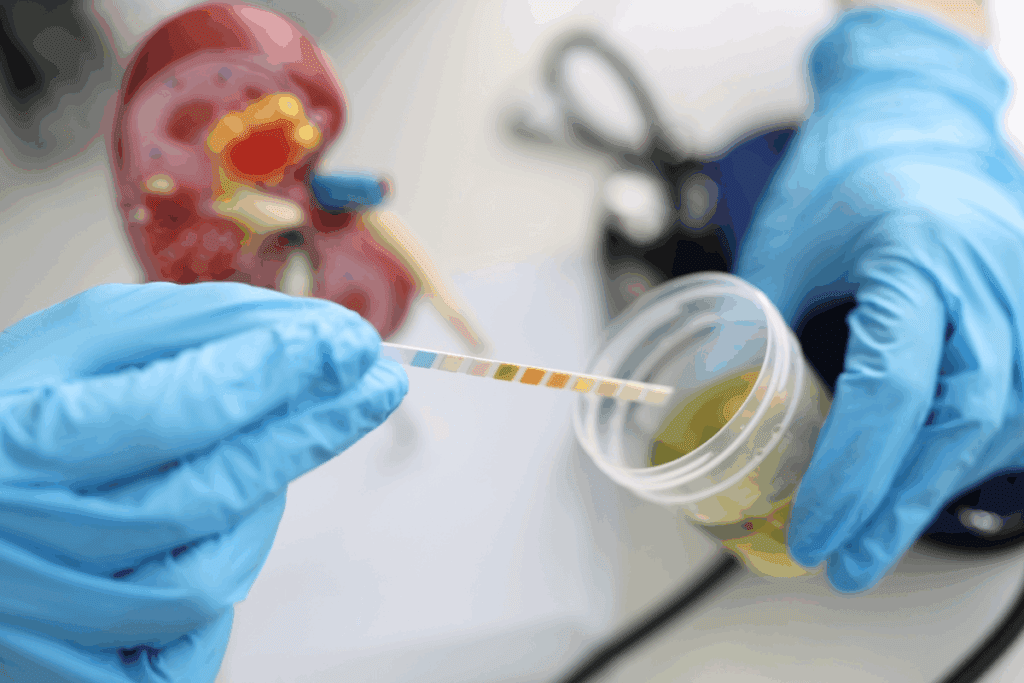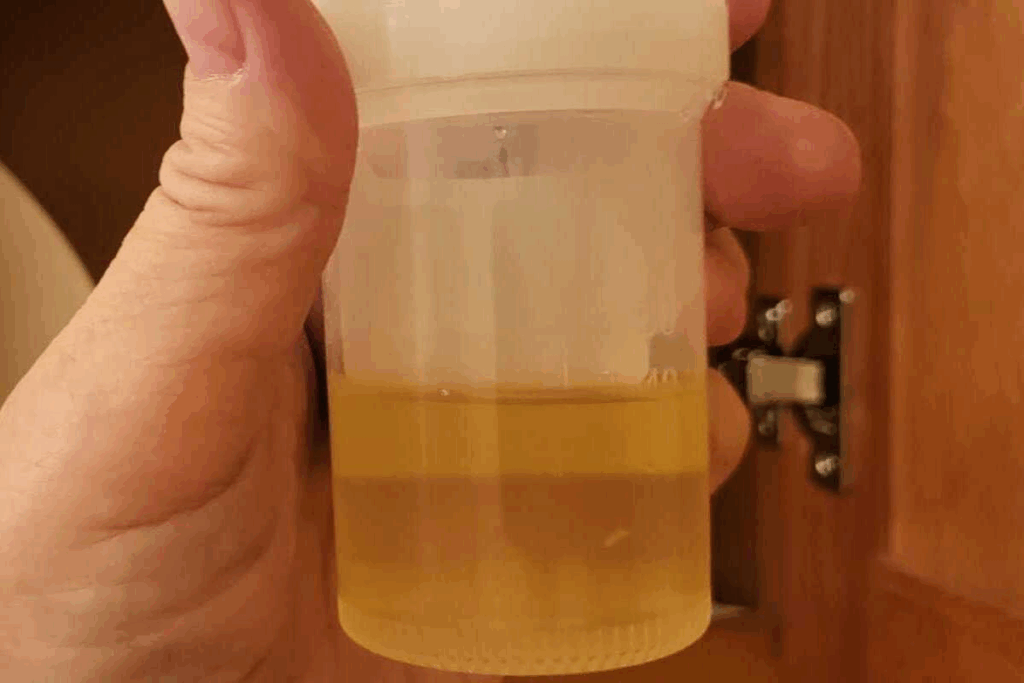Last Updated on November 25, 2025 by Ugurkan Demir

Seeing blood clots in urine can be scary and confusing. You might wonder if you need to rush to the ER or if you can wait for a doctor’s visit.
This symptom is called hematuria with clot formation. It means you need to see a doctor. Blood clots in the urinary tract can signal a problem, like an injury or stones in the kidneys or bladder.
Knowing what these clots look like and when to see a doctor is important. At Liv Hospital, we focus on you and use the latest medical methods. This ensures you get the best care.

Blood clots in urine are a sign of hematuria, a common issue in adults. Hematuria means there’s blood in the urine, which can be tiny or big enough to see.
Hematuria with clot formation happens when there’s a lot of bleeding in the urinary tract. This leads to big clots that you can see. It can be caused by infections, stones, or injuries to the urinary system.
Hematuria affects up to 30% of adults at some point. Not all cases have visible clots, but if you see them, it means there’s a big problem.
Blood clots in urine come from bleeding in the urinary tract. This bleeding can be from infections, stones, or injuries to the system.
| Cause | Description | Common Symptoms |
| Urinary Tract Infections (UTIs) | Infections in the bladder, kidneys, or ureters | Burning during urination, frequent urination |
| Kidney and Bladder Stones | Hard mineral deposits in the kidneys or bladder | Severe pain, nausea, difficulty urinating |
| Trauma or Injury | Physical injury to the urinary tract | Pain, swelling, difficulty urinating |
Knowing the causes and symptoms of hematuria and clot formation is key to getting the right medical help.

Blood clots in urine can look different, from string-like to darkened chunks. Knowing how they look helps figure out the cause and how serious it is.
Blood clots in urine might look like string-like or worm-like formations. These can be quite long and suggest bleeding from higher up, like the kidneys or ureters.
Seeing these stringy clots can mean different things. It could be due to:
Blood clots can also show up as red or darkened chunks in the urine. The color and texture can hint at where and why the bleeding is happening.
But, seeing how they look isn’t enough to know what’s going on. A doctor’s check-up is needed to find out why there are blood clots in the urine.
Blood clots in urine can be scary, but it’s key to know if it’s really a clot or something else. Some medicines and foods can change urine color or texture, making it hard to tell. We’ll look at how to tell blood clots from other things in urine.
Tissue fragments can look like blood clots, but they’re different. Blood clots are more gel-like or stringy and are red or brown. Tissue fragments are often irregular in shape and can be whitish or have a different texture. If you’re not sure, it’s best to talk to a doctor.
Here are some things to look for when trying to tell blood clots from tissue fragments:
Some medicines can change urine color, making it hard to tell if it’s a blood clot. For example, some antibiotics and laxatives can make urine red or orange. To tell if it’s a medicine or a blood clot, look for these signs:
As one study noted, “Certain medications can cause urine discoloration, which may be mistaken for hematuria.” Knowing your medicines and their effects on urine is important.
Some foods can also change urine color, making it hard to tell if it’s a blood clot. Beets, berries, and rhubarb are common foods that can make urine pink or red. To tell if it’s food or a blood clot, consider these points:
In conclusion, telling blood clots from other things in urine needs careful observation and thought. If you’re unsure about what you see in your urine, it’s best to talk to a healthcare professional for the right advice and help.
Blood clots in urine can signal a urinary tract infection (UTI). UTIs affect millions globally. They happen when bacteria get into the urinary system, causing inflammation and sometimes blood clots.
Bacteria in the urinary tract can irritate and inflame the bladder, ureters, or kidneys. This irritation can cause bleeding and lead to blood clots. The body’s fight against infection can also cause clots as it tries to isolate and fight off the bacteria.
There are several UTI types, each affecting different parts of the urinary system. These include:
Pyelonephritis, or kidney infection, is serious and can lead to complications if not treated quickly. Women are more likely to get UTIs because their urethra is shorter, making it easier for bacteria to reach the bladder.
UTIs show symptoms beyond just blood clots. These can include:
Spotting these symptoms early can help get medical help quickly. This can lower the risk of more serious problems like more blood clots or infection spreading to other parts of the urinary system.
Blood clots in the urine can mean several health issues, like kidney and bladder stones, prostate problems, and serious conditions. Knowing these causes is key to finding the right treatment.
Kidney and bladder stones are hard deposits that form when urine minerals crystallize. These stones can cause a lot of pain and lead to bleeding, which might result in blood clots in the urine.
Stones often form due to not drinking enough water, certain diets, or genetics. Symptoms include severe pain, nausea, and trouble urinating. If stones cause bleeding, it can lead to blood clots.
| Condition | Common Symptoms | Potential Complications |
| Kidney Stones | Severe flank pain, nausea, vomiting | Bleeding, infection, urinary blockage |
| Bladder Stones | Difficulty urinating, painful urination, frequent UTIs | Bleeding, infection, bladder damage |
Prostate issues, mainly in men, can cause blood clots in the urine. An enlarged prostate or prostatitis can irritate and bleed in the urinary tract.
Prostate problems often include trouble starting to urinate, weak urine flow, and needing to urinate often. Sometimes, these issues can cause bleeding with clot formation.
Urinary tract injuries, from trauma, surgery, or medical procedures, can cause bleeding and blood clots in the urine. The injury’s severity often matches the bleeding amount.
Symptoms of urinary tract injuries include pain, trouble urinating, and visible bleeding. Quick medical check-ups are needed to manage these injuries and avoid further problems.
In some cases, blood clots in urine can signal serious conditions like cancer or severe infections. These need immediate medical care to prevent serious issues.
It’s vital to get a detailed medical check-up to find out why there are blood clots in the urine. Early diagnosis and treatment can greatly improve outcomes for these conditions.
It’s important to know the difference between painful and painless blood clots in urine. This helps figure out how serious the problem is. Whether you feel pain or not can tell doctors a lot about what’s going on.
Painless blood in the urine might mean something serious is wrong. It could be bladder cancer, kidney injuries, or other big health problems. It’s key to check this kind of blood in urine carefully to find out what’s causing it.
Some serious conditions that might show up as painless hematuria include:
Painful blood in the urine usually means something less serious but uncomfortable. It can be due to kidney stones, urinary tract infections (UTIs), or other problems in the urinary tract. The pain can feel different depending on the cause.
| Cause | Typical Pain Characteristics |
| Kidney Stones | Severe, colicky pain radiating to the groin |
| Urinary Tract Infections | Burning sensation during urination |
| Bladder Inflammation | Suprapubic pain, frequent urination |
The way pain feels and where it is can tell doctors a lot. For example, if the pain is sharp and moves to the groin, it might be kidney stones. A burning feeling when you pee could mean a UTI. Where the pain is can also give clues, like flank pain for kidney issues or suprapubic pain for bladder problems.
Understanding these pain patterns helps doctors guess what’s wrong and how to fix it.
Doctors look at the pain or lack of pain from blood clots in urine to figure out what’s going on. This helps them come up with the best treatment plan.
Knowing the emergency warning signs for blood clots in urine can save your life. If you see these symptoms, get medical help right away. This can prevent serious problems.
Severe pain with blood clots in urine is a big warning sign. This pain might be in your lower abdomen, back, or flank. Severe pain often means there’s an obstruction or infection that needs quick treatment.
Not being able to urinate or having a sudden blockage is an emergency. This can cause acute kidney injury or urinary retention. These are very painful and can be dangerous.
Seeing signs of infection like fever, chills, or a burning feeling while urinating with blood clots is urgent. Sepsis, a serious condition, can happen if the infection spreads. It’s key to spot these signs early to avoid severe problems.
Dizziness, weakness, or fainting with blood clots in urine might mean you’re losing a lot of blood or are very dehydrated. These signs need quick checking to find out why and treat it right.
In short, if you have severe pain, can’t urinate, see signs of infection, or feel dizzy or faint with blood clots in urine, get emergency medical care right away. Quick action can greatly improve your chances and stop serious issues.
It’s key to understand the gender-specific aspects of blood clots in urine. This is for accurate diagnosis and treatment. Blood clots in urine can be caused by different factors in men and women. This is due to physiological and pathological differences.
In women, blood clots in urine can be linked to endometriosis. This is when tissue like the uterine lining grows outside the uterus. It can cause hematuria. Other causes include urinary tract infections (UTIs), which are more common in women.
Gynecological conditions and menstrual contamination can also be mistaken for hematuria.
Women with blood clots in urine need a thorough evaluation. This is to find the underlying cause. It could be from infections to more serious conditions like bladder or kidney stones.
In men, blood clots in urine often point to prostate issues. This includes prostatitis or benign prostatic hyperplasia (BPH). Urinary tract infections, though less common, can also cause hematuria with clots. Other causes include kidney stones and bladder issues.
Men with blood clots in urine should get medical attention. This is to find the cause, as it may be a sign of an underlying condition that needs prompt treatment.
Both men and women should know the possible causes of blood clots in urine. They should also understand the importance of getting a medical evaluation. This is to address any underlying conditions.
When you arrive at the ER, doctors quickly check for blood clots in your urine. This first step is key to figuring out how serious the problem is and what to do next.
Doctors start by asking you about your health and symptoms. They want to know about any pain, how long you’ve had symptoms, and any past health issues. They also do a physical exam to look for any signs of trouble.
Key aspects of the initial assessment include:
To find out why you have blood clots in your urine, doctors run several tests. These might include:
Emergency treatments aim to fix the root cause and ease symptoms. This might include:
In some cases, doctors might need to do more serious procedures to remove the clot or fix any blockages in the urinary tract.
You might need to stay in the hospital if your condition is serious or if complications arise. This could be due to:
In the hospital, the medical team can keep a close eye on you. They can give you the care you need to get better and stay stable.
Not every blood clot in urine needs an emergency room visit. Knowing when to see a doctor without rushing is key. It’s wise to be cautious, but some situations allow for a scheduled visit.
If you have mild blood in your urine with clots and no severe pain, you might not need urgent care. But, seeing your doctor is important to find out why. Mild symptoms that can wait include:
After an ER visit for blood clots in urine, follow-up care is vital. Your doctor might suggest more tests or monitoring. Follow-up care may include:
In some cases, your doctor might tell you to watch your symptoms at home. This means tracking the blood clots’ size and changes in urination. When monitoring at home, be sure to:
If you’re peeing out clumps of blood, watch closely and seek help if symptoms worsen. By knowing when to seek non-emergency care and monitoring symptoms, you can work with your doctor to find the cause.
Knowing why you have blood clots in your urine is key to finding the right treatment. Seeing clots of blood when you pee is scary. We need to tackle this symptom in a detailed way.
When underlying infections cause blood clots, we use antibiotics. We find out what infection you have to give the best treatment.
Kidney and bladder stones also cause blood clots. We treat this with pain meds, drinking lots of water, and sometimes surgery.
For men, prostate issues can lead to blood clots. We might use meds to shrink the prostate or surgery to fix it.
When blood clots are a sign of more serious conditions like cancer, treatment is more complex. We work with many doctors to help you.
It’s very important to see a doctor if you have blood clots in your urine. Quick action can make a big difference.
Blood clots in urine can signal a serious health issue. It’s key to know when to get medical help. This article covered blood clots in urine, their look, causes, and the difference between painful and painless hematuria.
It talked about emergency signs that mean you need to see a doctor right away. These include severe pain, trouble urinating, and signs of infection or sepsis. Recognizing these symptoms and acting fast is important to avoid worse problems.
If you see blood clots in your urine, getting medical help is a must. This article stressed the need for quick medical care for conditions that cause blood clots in urine. Knowing when to seek medical help is the first step to getting the right treatment and avoiding complications.
Blood clots in urine can look like strings or worms. They might be red or dark. The look can change based on the cause.
Yes, if you have severe pain or can’t pee. Also, if you see signs of infection, feel dizzy, or weak. Go to the ER right away.
Causes include infections, stones, and prostate issues. Also, injuries and serious conditions like cancer can cause them.
Yes, infections can cause blood clots. This happens because of inflammation and irritation in the urinary tract.
Blood clots are red or dark and look like strings or chunks. They’re different from food or medicine colors because of their shape and symptoms like pain.
Both men and women can get blood clots in urine. Women often get infections, while men get prostate problems more.
At the ER, you’ll get checked and tested. You might need emergency treatment. If it’s serious, you might need to stay in the hospital.
If your symptoms are mild, you can watch them at home. But, always follow up with your doctor. Go to the ER if your symptoms get worse.
Treatment depends on the cause. It might include antibiotics, managing stones, or treating prostate issues. For serious conditions, there’s specific treatment.
Painless hematuria can mean a serious problem, like cancer. You should get checked by a doctor to find out.
If your symptoms are mild and not severe, you can wait to see your doctor. But, if you have pain, can’t pee, or signs of infection, go to the ER.
Government Health Resource. (2025). What Do Blood Clots in Urine Look Like. Retrieved from https://www.niddk.nih.gov/health-information/urologic-diseases/hematuria-blood-urine
Subscribe to our e-newsletter to stay informed about the latest innovations in the world of health and exclusive offers!